As an ASO professional, having the ability to craft quality app store marketing hypotheses is an essential skill to learn; you’ll struggle to succeed in the field of app store optimization without it. Why? Because a strong hypothesis is the foundation of all successful ASO test.
We found that app store tests with strong hypotheses are 90% more likely to be ‘successful’ – industry lingo for producing an actionable insight that drives a conversion rate improvement. Having a strong hypothesis helps you avoid having to explain why time and resources were spent on a test that failed to produce useful learnings.
Once you master the art of hypothesizing, you’ll be able to focus your app store page testing efforts and achieve higher conversion rates in less time.
In this article, we’ll teach you what makes a good hypothesis (with examples!), how to conduct thorough hypothesis research, and what to avoid when hypothesizing. Let’s get started!
Check all other articles in our Ultimate App Store Test Series:
Part 2: Creative Design
Part 3: Driving Traffic
Part 4: Analyzing Results
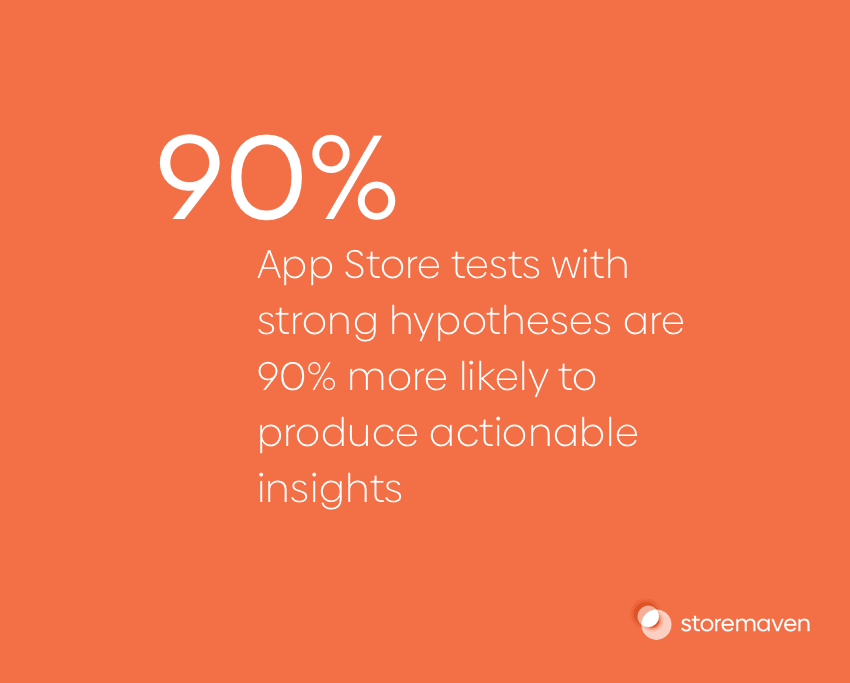
A hypothesis – the definition
In terms of app store optimization, a hypothesis is a solid intention that can be proven or disproven through testing and will reveal actual learnings about a target audience – information that will teach you something about why your app was downloaded, or not.
What separates a good hypothesis from a mediocre one?
If you hope to master the testing cycle, as we call it here at Storemaven, you’re going to need the answer to this question. Fortunately, we have it for you! A good app store hypothesis is the following.
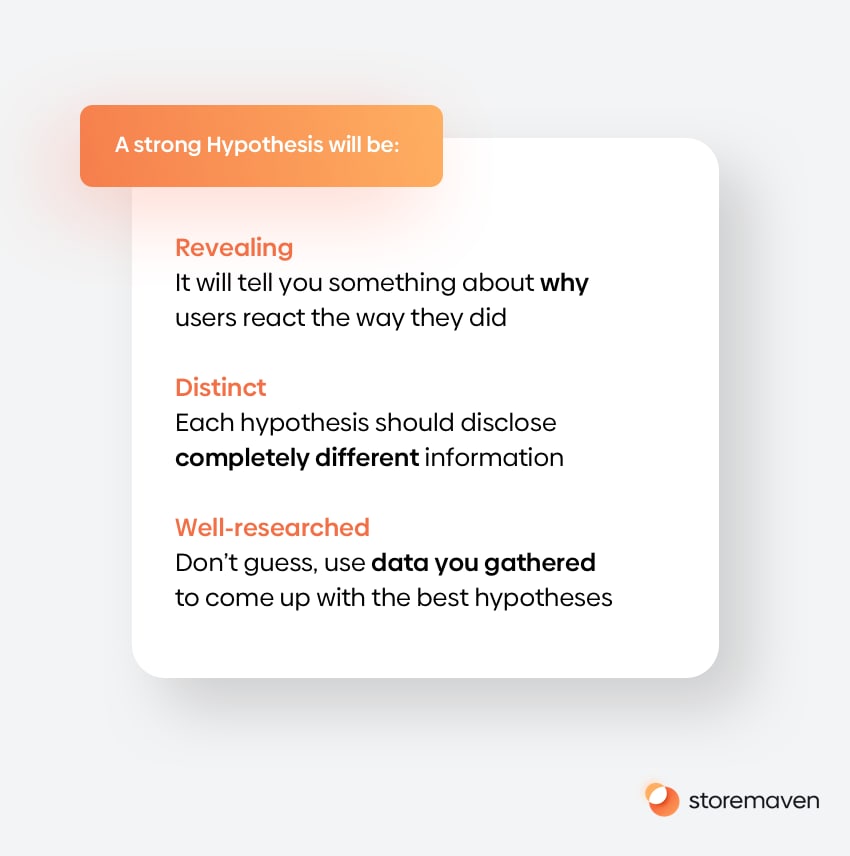
Revealing
What will your hypothesis tell you about your users? All great app store page hypotheses give developers new insight into their target audiences.
For example, if you were to hypothesize that “A yellow icon will generate more clicks than a blue icon,” and test your theory, you wouldn’t actually learn anything substantial about your users. Maybe you discover that yes, a yellow background does generate more clicks but until you know why this is the case, the information is useless to you.
Make sure all of your hypotheses reveal new information about your app store visitors so that you can use those details to improve your optimization efforts.
Distinct
Does your current hypothesis closely resemble previous hypotheses you’ve made? If the answer is yes, you should develop a more distinct hypothesis that will uncover new insights. Many ASO managers run tests that are too nuanced to be helpful.
Here’s an example of two distinct hypotheses:
- Showing my app’s ease of use will prompt engagement.
- Competitor differentiation messaging will outperform use case messaging.
See how these two hypotheses will reveal completely different things about an app’s target audience? Make sure your hypotheses are similarly distinct.
Well-Researched
Lastly, good hypotheses are well-researched.
Dig through your competitors’ creative assets using the ASO Tool Box, which will allow you to easily preview and download their icons, screenshots, etc. for analysis. Read through your reviews to learn what your users like and don’t like about your app. Take a look at your analytics to discover which app features are most engaged with.
Then take this wealth of information and use it to develop well-informed hypotheses that pertain to your exact situation in terms of ASO.
Four Great Hypothesis Examples
Since your hypotheses are key to the success of your app store page testing efforts, let’s take a moment to look at four great hypothesis examples. This way you can get a feel for what separates a quality hypothesis from a mediocre one.
1. Social Proof
In competitive markets, social proof can help differentiate one app from another. But of course you won’t actually know if this is true for your app until you test it. Here’s an example of a quality social proof oriented hypothesis:
“Including social proof elements in the first impression screen will boost install rates.”
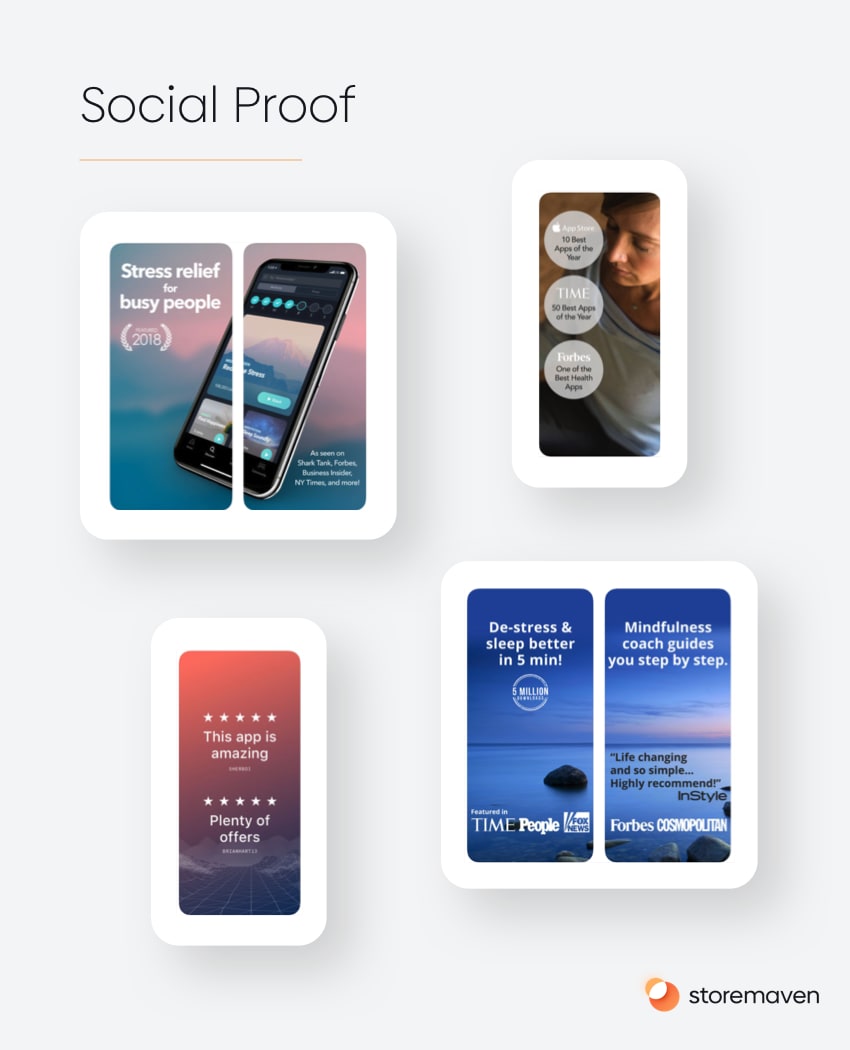
2. Feature-Oriented
Why should a user download your app? Because it’s chock-full of amazing features! Test this theory with a well-crafted, feature oriented hypothesis such as:
“Highlighting specific and highly used features of our app will increase our conversion rate (CVR).”
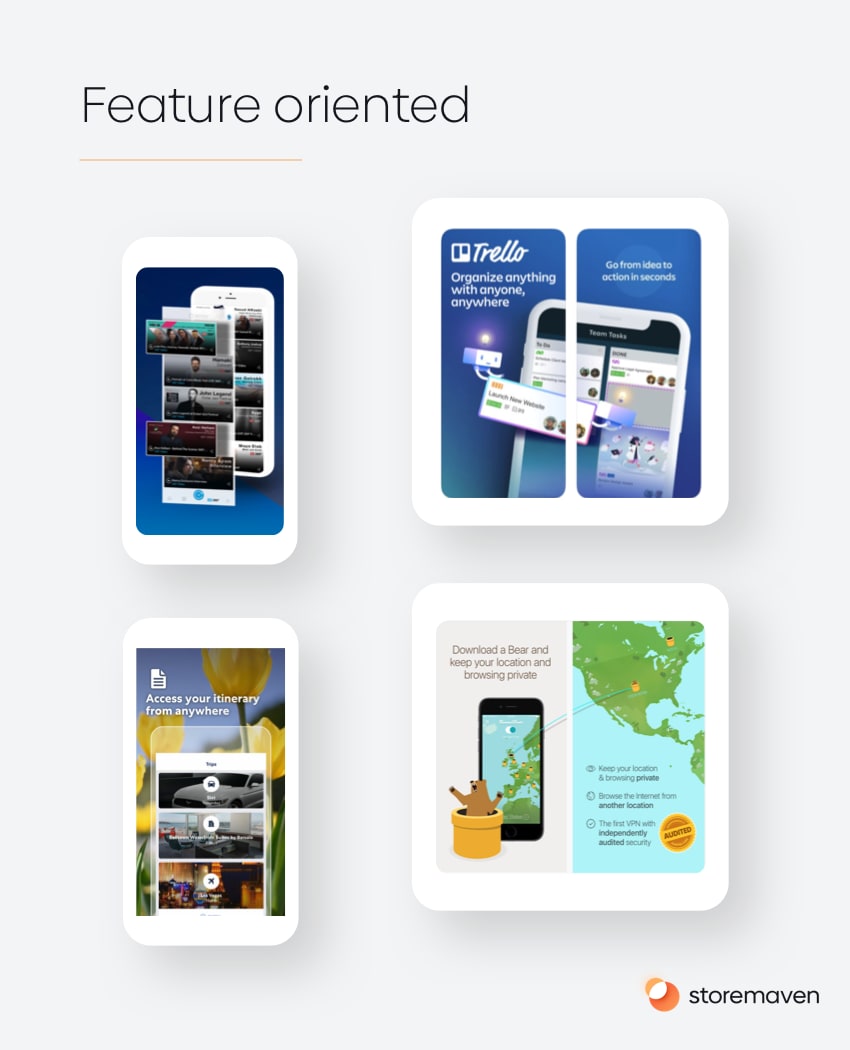
3. Characters
Awesome characters are a huge draw for many app store users. Once they see that a game will allow them to play a fantastical hero, they’re more likely to whip out their wallets and purchase it ASAP. If you’ve developed a character-driven game, you might hypothesize something like:
“Users prefer to see screenshots that feature our cast of characters.”
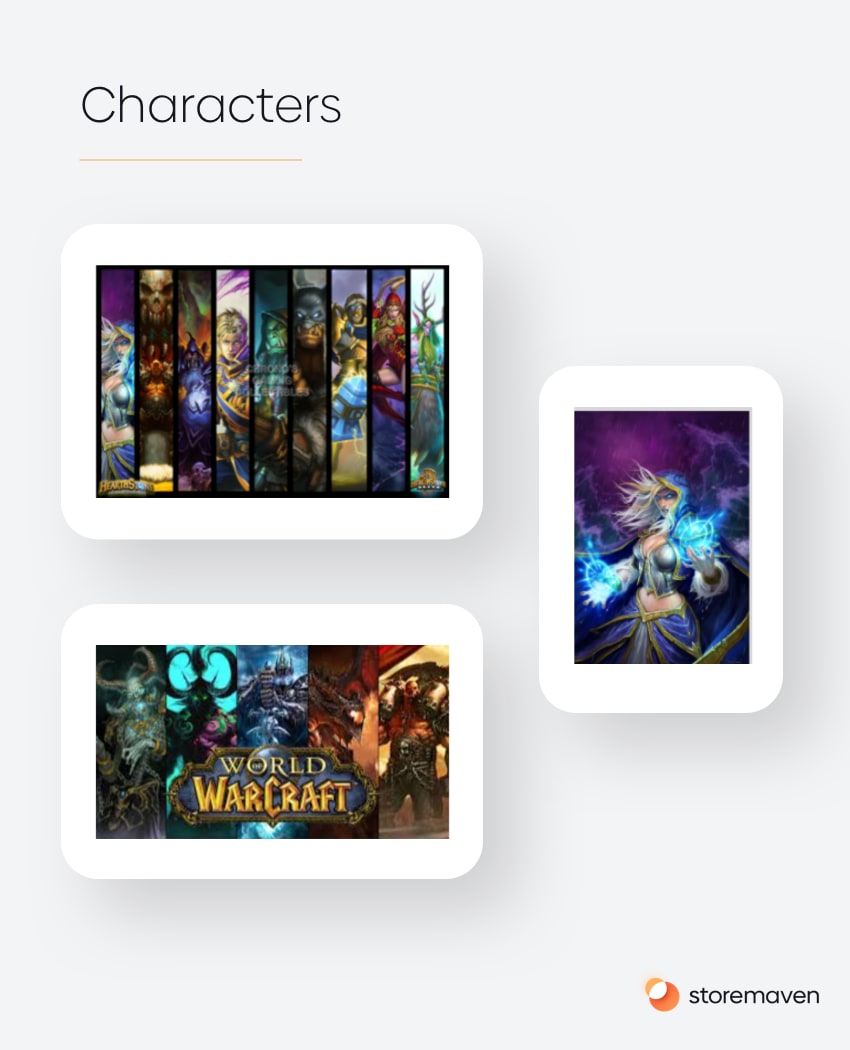
4. Gameplay Mechanics
How do users play your game? Many Apple App Store and Google Play Store users quickly scan through apps looking for gameplay mechanics that tickle their fancy. If this describes your audience, you might consider testing a gameplay mechanics hypothesis:
“A clear view of gameplay mechanics in the first impression will boost conversions.”
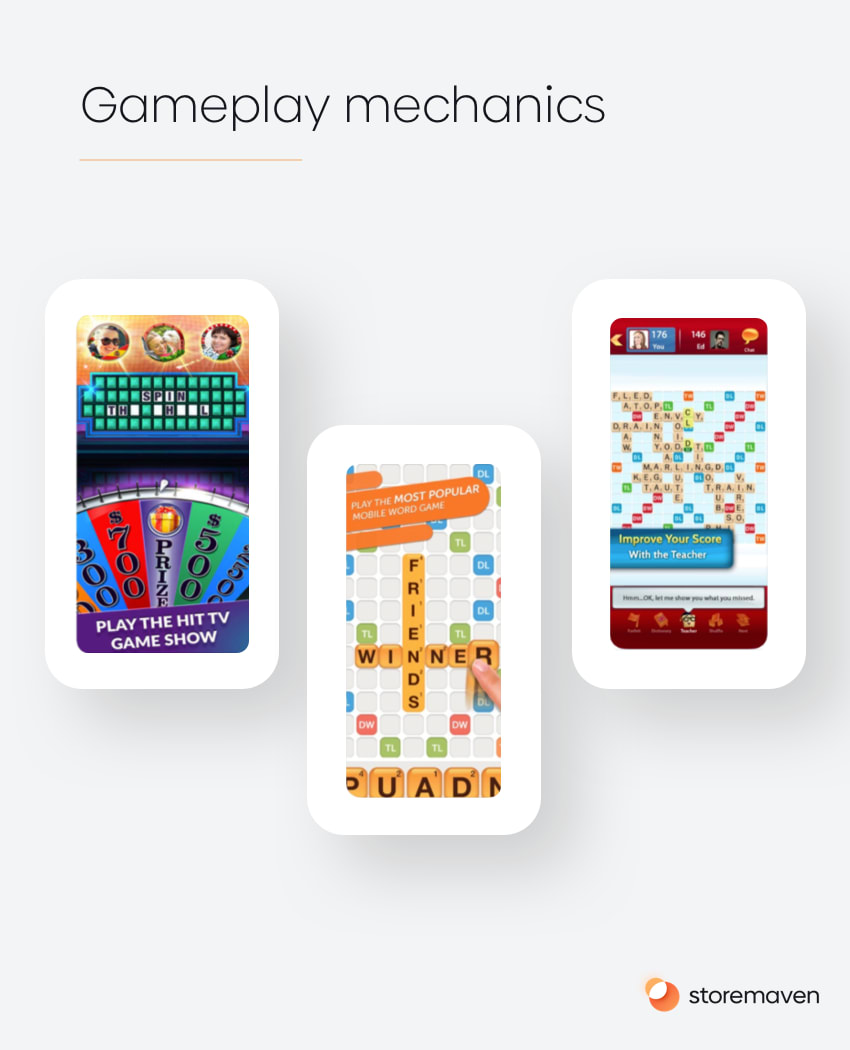
We’re just illustrating what a good hypothesis looks like to inspire you to create your own, don’t simply copy the hypotheses above! Do your research and make sure they relate to your specific audience.
A Framework For Solid Hypothesis Research
When it comes to hypotheses, the battle’s won in the research phase. With that in mind, let’s look at a three-step process you can use to properly research your app-based theories.
1. Know Your Users
When crafting hypotheses, always start with in-depth audience research. Who are your users and where do they live? Why do they need an app or game like yours? And what specific features/gameplay elements get them most excited to hit the download button?
Answers to these questions are essential, but they’re not always easy to obtain. After all, you can’t post a “How Did You Hear About Us?” form in the Apple or Google Play stores.
Fortunately, we have a few tips for you:
- Understand User Types: There are two types of app store users, Decisive and Explorative. Decisive users choose to download an app (or not) after viewing the first impression screen. Explorative users take time to investigate apps thoroughly before deciding to install them. Based on our research, 68.4% of Apple App Store users and 76.4% of Google Play users are decisive. This means that in all likelihood, your users will only view your first impression screen, which is helpful to know.
- Study Your Past Marketing Initiatives: Do you run Facebook ads or Adword campaigns? Have you ever hosted a webinar? Do you post content on your website to try and attract your target audience? If you answered “yes” to any of these questions, you have a wealth of audience information at your fingertips! Analyze your data to discover who’s clicking on your ads, attending your webinars, visiting your website, etc. Then use these details to paint a clearer picture of your user base.
- Use a Tool Like Storemaven: Our team will create an exact replica of your Apple App Store or Google Play store page, put it in a sandbox environment, and drive actual traffic to it. This will allow you to learn exactly who your audience is and how they interact with your page via expert audience tracking.
During your user research, do your best to uncover the age, gender, location, and interests of your audience. These crucial bits of information will give you the insights you need to craft better app store pages and convert more visitors into lifelong customers.
Note: your audience will likely change over time. Because of this, you need to study your users on a regular basis to make sure you’re targeting them properly.
2. Research Your Market
Next, you need to research your market, which means taking a good, hard look at your direct competitors. Who are they? What do their app store pages look like? How do they differentiate themselves? Do they feature videos? What kind of screenshots do they use?
Also, when attempting to increase conversion rates in markets that are culturally far removed from those you know, it’s crucial to research the local culture, habits, and ways of communication.
There are a couple of different ways to do market research:
- The Manual Way: If you’re short on funds but have time to spare, you can manually research your competitors. Simply type the keywords you target into the Apple App Store and Google Play store search bars and see which apps appear. Or view the rankings in your app’s category. Or type [Keyword] + App into Google and see what the search engine digs up. Basically, use the free tools at your disposal to uncover competitors and then manually analyze their app store pages for insights.
- The Faster Way: If you’re looking for a quicker and more accurate way to research your competition, try using a tool like ASO Tool Box or Appfigures. ASO Tool Box will allow you to easily download and view your competitors’ creative assets so that you can understand how they assemble their app pages. ASO Tool Box is a free tool and AppTweak pricing depends on the features required. With Appfigures you can optimize for more organic keywords and get insights into keyword ranks. You can also identify more keywords that will increase your views and get you more downloads.
Remember, you’ll need to do competitor research for every market you’re in. There’s a good chance your competition in the U.S. will be different than it is in India, for example.
3. Analyze Your Data
As you research your hypotheses and begin running tests, it’s important to analyze the data you receive back. Was your initial hypothesis correct? If so, why? If not, why? Most importantly, how will your findings inform your next hypothesis and the one after that?
You should always question your hypothesis and realize that there are unforeseen factors at play. For example, if your downloads went through the roof in April 2020, is this because of a new ASO strategy or simply because COVID-19 resulted in your target users having more time on their hands during lockdowns?
It’s your job to find out! Use your data to create informed hypotheses. Then test them and tap into the results to craft better hypotheses in the future that help boost your conversion rates.
How NOT to Develop a Hypothesis
So far we’ve covered what makes a good hypothesis, explored a few quality hypothesis examples, and given you a three-step process for hypothesis research. To help, we want to finish with some things to avoid. Do NOT do the following:
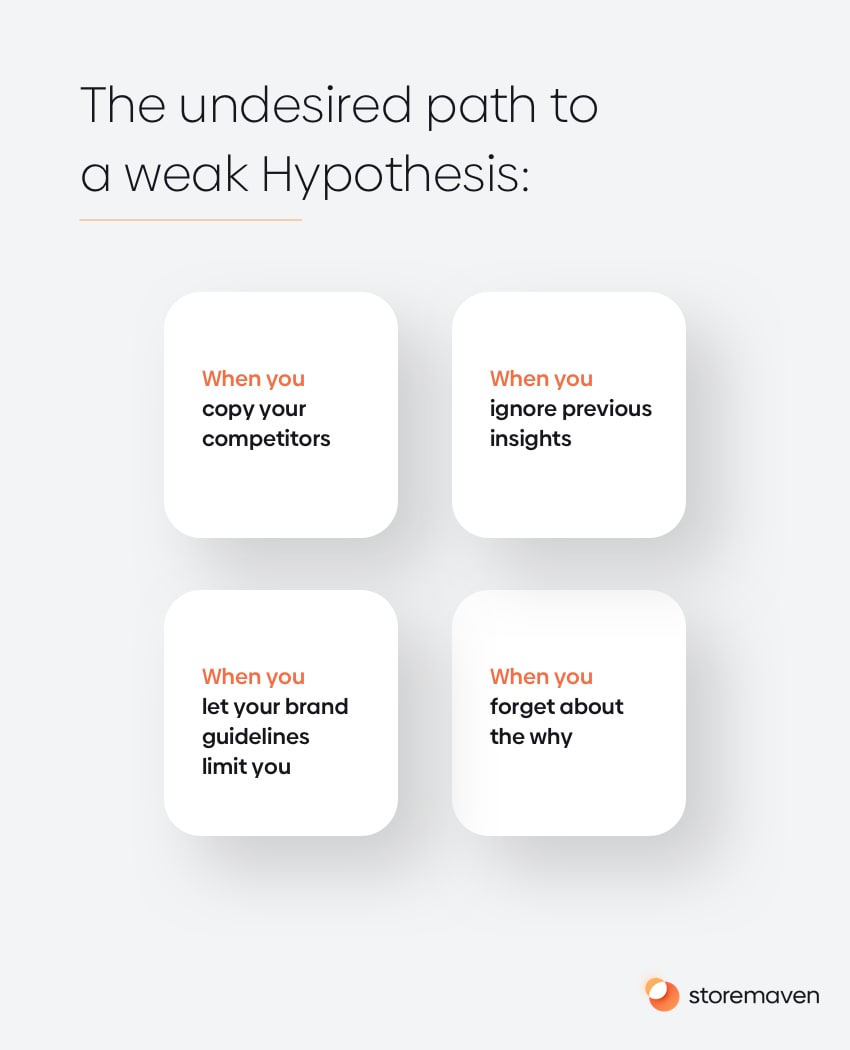
Don’t Play the Copycat Game
While market research is important, you shouldn’t copy and paste any competitor’s complete strategy. Your app or game is (hopefully!) unique, which means it will require a unique ASO strategy to properly optimize its app store page.
Use competitive research as a starting point. Take what’s working for similar apps and adjust it to fit your needs and specific user base. But always use your invaluable brain and any available data points to determine which elements to copy and which to toss by the wayside.
Don’t Neglect Your Previous Insights
Like we mentioned above, your previous hypotheses should inform your future ones. If you neglect the insights you gleaned in the past, you’ll waste a lot of time and money. Instead, use what you’ve already learned to inform your approach to new hypotheses and tests.
At the same time, don’t get too married to specific ideas. Things change quickly in ASO and you should always question your hypotheses to find true answers.
Don’t be Limited by Brand Guidelines
ASO managers can run into problems when they don’t have full control over creative assets.
For example, you might hypothesize that a character-based logo will outperform a text-based one. But if your company’s branding completely revolves around its text-based logo, you might face internal resistance when attempting to change it.
Do your best to work with other departments. Show them the potential benefits of adjusting your logo and assure them that if the change doesn’t produce significant gains, you’ll switch it back immediately. Or, simply run your tests in a sandbox environment like Storemaven so that you can hypothesize about anything you like without touching your actual app page!
Don’t Forget About Your Why
Finally, don’t ever test a hypothesis that isn’t buoyed by a strong why. If you don’t have a specific reason for hypothesizing about something, don’t move forward with it.
So many ASO managers make mistakes because they test for the sake of testing. It’s much better to hypothesize about something that could result in significant gains for your company. Then test the hypothesis and act on your findings in an appropriate way.
In Conclusion: Your aim is to always build better hypotheses
Your hypotheses make up the foundation of your app store testing process. Without them, you’ll be unfocused and waste a lot of valuable time and energy.
Take the time to research your users and market. Then use your findings to craft informed hypotheses, test them, and use the results to improve future hypotheses. If you can do that, you’ll be able to run accurate tests that provide important insights.
Happy? Feeling more confident about the dos and don’ts? Well, we’re not stopping there! Keep following us for part 2 in our Ultimate Test series, where we’ll focus on the creative design process. Stay tuned.
















